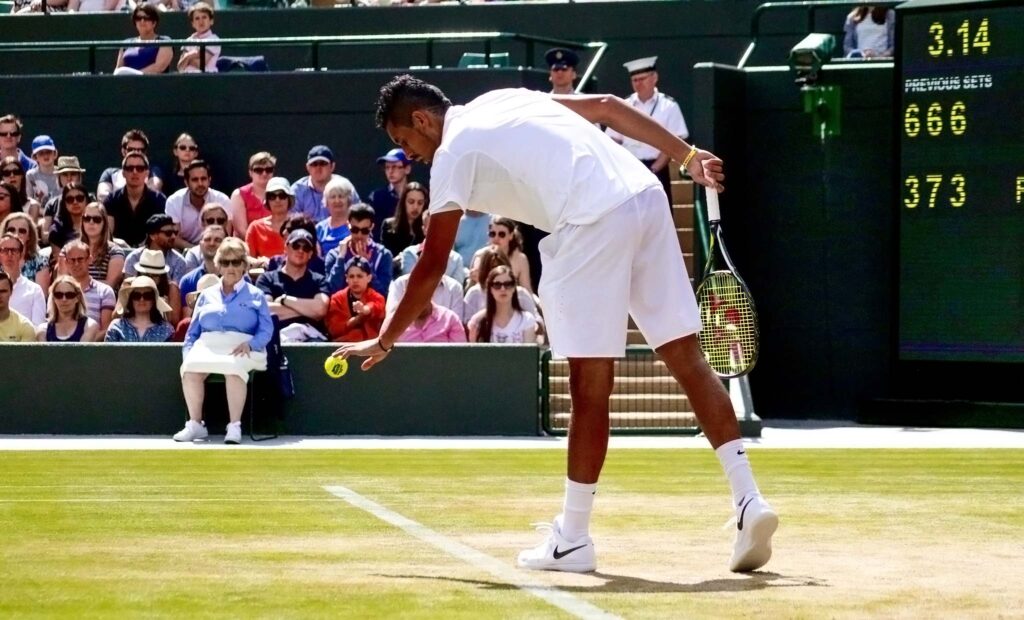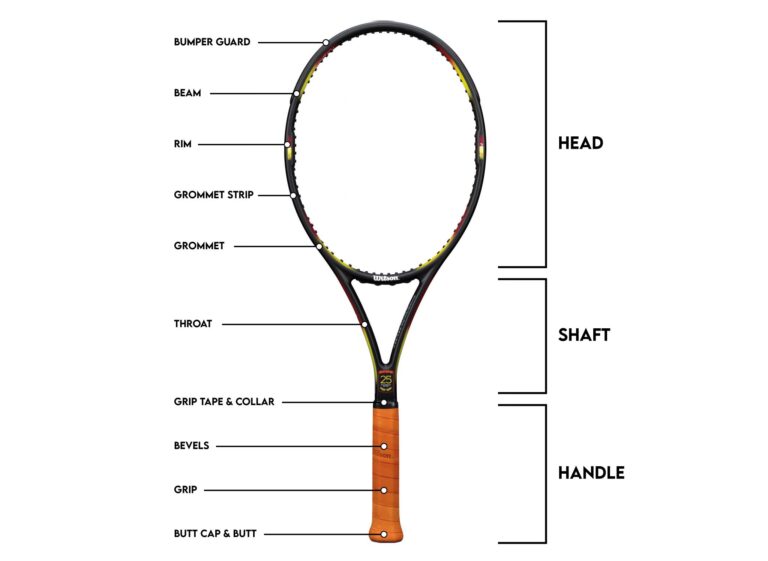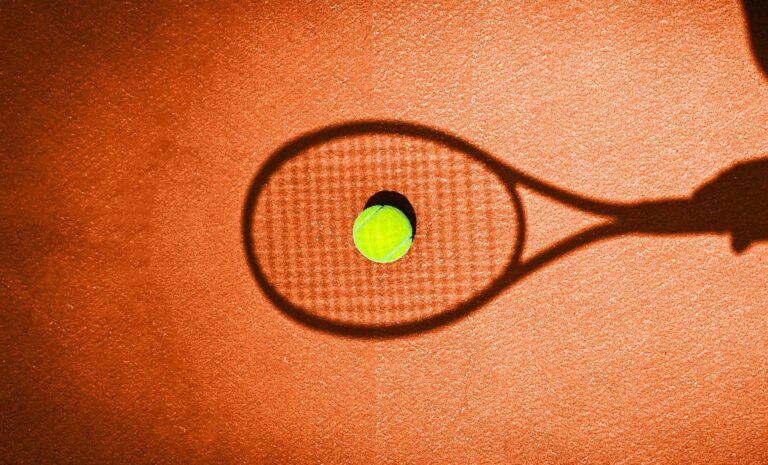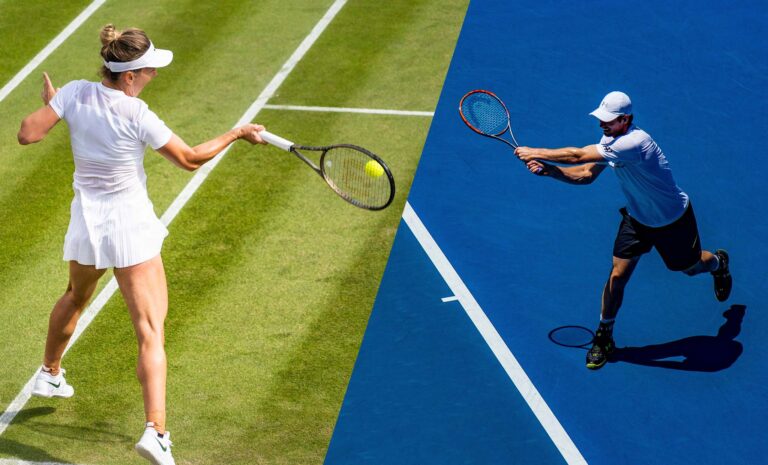For most tennis players and fans, a serve always involves tossing the ball up and hitting it above head height, right? However, the underarm serve has recently made a fair few appearances in pro tennis and is becoming a more common shot. So, to give you a bit more information about the shot, we’ve put together a guide to the underarm serve in tennis.
What is an Underarm Serve in tennis?
The underarm serve, also called the underhand serve, involves dropping the ball and hitting a serve with an underhand motion rather than tossing the ball up for a traditional overarm serve. It’s a somewhat controversial shot that is often used as a way to surprise the opponent, particularly when they are standing far behind the baseline to return.
A Short History of the Underarm Serve
In modern tennis, it’s often Nick Kyrgios who is credited for the underarm serve though it was used long before the Aussie came around. In fact, it was first used by a 17 year-old Michael Chang during his 1989 French Open Fourth Round match against then world number 1 Ivan Lendl. With the pair locked in a deciding set after four hours of play, Chang was suffering badly from cramp and chose to throw in an underarm serve. Chang went on to win the match and the tournament, perhaps making it one of the most iconic shots in history.
The underarm serve has made a few rare appearance since then, though its resurgence on the pro tour really began when Nick Kyrgios used the shot against Rafael Nadal at the 2019 Mexican Open in Acapulco. From that moment on, the underhand serve became a regular feature in Nick Kyrgios’ game and has been used by other players including the likes of Daniil Medvedev, Alexander Bublik and Frances Tiafoe and has even been used on occasion by Andy Murray and Carlos Alcaraz.

Can you serve underarm in tennis?
Naturally, the first question that springs to mind is: is the underarm serve a legal shot? The answer is yes! According to the ITF Tennis Rules, a service motion is defined like this:
"The server shall stand at rest with both feet behind the baseline and within the imaginary extensions of the centre mark and the sideline. The server shall then release the ball by hand in any direction and hit the ball with the racket before the ball hits the ground."
ITF Tennis Rules 2023
In other words, during a serve you can toss the ball in any direction you want, making the underarm serve a perfectly legal shot in tennis.
Is the Underarm Serve disrespectful?
Despite being perfectly within the rules, the underarm serve does have a slight negative connotation around it and is seen by some fans to be cheeky and disrespectful. However, that’s a perspective that is quickly changing as the shot has become a crowd pleaser, cheered on by fans who have the luck to witness it in action.
In our opinion, there’s no reason why it should be any more disrespectful than standing 5-6 metres behind the baseline to return serve. It’s a perfectly valid shot/tactic in tennis and there’s no reason why players shouldn’t use it. But don’t take our word for it.
Andy Murray has used the underarm serve on several occasions, with the most notable being during his first-round win over James Duckworth at Wimbledon 2022.
During his press conference after the match, Murray defended his use of the underarm serve by saying…
"He changed his return position, that’s why I did it. He was standing very close to return. He was struggling a little bit on the first-serve return, so he stepped probably two meters further back. As soon as I saw him step further back, I threw the underarm serve in. I personally have no issue with players using it. I never have. Certainly, more and more players have started returning from further behind the baseline now to give themselves an advantage to return. The underarm serve is a way of saying: If you’re going to step back there, then I’m going to possibly throw that in. I don’t know why people have ever found it potentially disrespectful. I’ve never understood that. It’s a legitimate way of serving. I would never use an underarm serve if someone was standing on the baseline because I think it’s a stupid idea because they’re going to track it down and it’s easy to get. If they stand four or five meters behind the baseline, then why would you not do that to try to bring them forward if they’re not comfortable returning there? Tactically, it’s a smart play. No one says it’s disrespectful for someone to return from six meters, whatever, five meters behind the baseline to try to get an advantage. So I used it not to be disrespectful to him but to say: If you’re going to step further back to return the serve to give yourself more time, then I’m going to exploit that."
Andy Murray
The Nick Kyrgios Underarm Serve
One of the players best known for using the underarm serve is, of course, Nick Kyrgios. Since using it against Rafael Nadal in Acapulco back in 2019, the Aussie has built the underarm serve into his game, using it sparingly but far more often than other players on tour. Paired with his huge first serves, which are some of the fastest serves in tennis, the underarm serve is yet another weapon in the Nick Kyrgios game.
But what makes it such a special shot is not the actual underarm serve, but his ability to disguise it and catch his opponent by surprise. Kyrgios’ preparation leading up to the serve, including his low ball bounce before he hits the ball, is exactly the same for both serves, making it all the more difficult to spot early.
And with many of his opponents standing well behind the baseline to return his powerful and unpredictable serve, throwing in an underarm serve from time to time can really help get him the occasional cheap point. Most importantly though, it disrupts his opponent’s rhythm and forces them to come a little closer to the baseline in case he does it again.
How to Hit an Underarm Serve
Whether you’re struggling to hit an overarm serve or simply want to mix things up and catch your opponent off guard, using an underarm serve can be very useful even at an amateur level. That being said, hitting an effective underarm serve is actually harder than it looks, so we’ve broken it down into a few simple steps:
1. Choosing the Right Moment
The first step, and perhaps the most important, in playing an underarm serve is choosing the right moment to use it.
If your opponent is too close to the net, the serve will be pretty easy to track down, giving your opponent a chance to end the point. Instead, use the underarm serve when your opponent is actually standing pretty far back to return. What’s more choosing the right side of the court to use it on is just as important. The sidespin used on the shot makes it naturally easier for right handed players to use the underarm serve on the ad-side of the court, while it’s easier for left handers to use it on the deuce side.
2. The Grip
As with every shot, you’ll need to find the right grip to use. Much like with a traditional serve, the best grip to use for an underarm serve is a continental grip as you’ll need to put plenty of slice and sidespin on the ball.
3. The Preparation
Perhaps the most important step in hitting an underarm serve is in the preparation leading up to the serve. The key thing here is to make sure that your opponent doesn’t see it coming, so setting up in the exact same way you do for a traditional serve is crucial. Stand in the same place and bounce the ball as you normally would. Bouncing the ball is also very important as it helps disguise the the ball drop when you’re actually going to hit the underarm serve.
If you don’t normally bounce the ball before serving, it may be worth building that into your service motion if you want to take full advantage of the underarm.
4. The Ball Toss/Drop & Hitting the Ball
According to the rules, you can toss the ball in any direction, though for an underarm serve it’s more of a ball drop. After bouncing the ball as you normally would, simply let the ball drop. To hit the ball, you’ll want to make contact with it a little below knee height and hit it with a slice motion, usually with a pretty heavy amount both backspin and sidespin.
Getting the motion right takes a fair bit of practice, though the key is in making sure you don’t slow the shot down as it needs the spin to really be effective.
5. Playing the Point
And last but not least, play out the point. Assuming you don’t hit an ace with your underarm serve, the final step is to play the point out as you would normally. In many cases, you’ll find that an underarm serve may not be good enough to get you an ace, but it should be very effective in moving your opponent out of position and setting you up nicely for the next shot.
While the underarm serve is still a rarity in tennis, it’s definitely becoming far more popular and it’s appearances in pro tennis are certainly making it more common in amateur tennis too!
And if you’re interested in other specialty tennis shots, be sure to check out our guide to the tennis tweener.
Featured Image by Ryan Hurril / Flickr.




